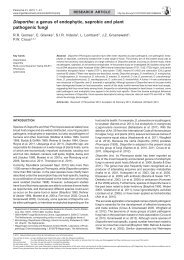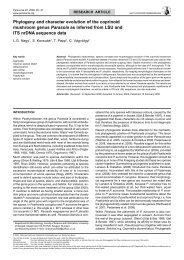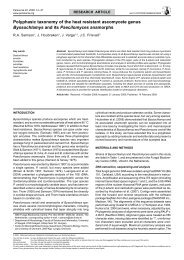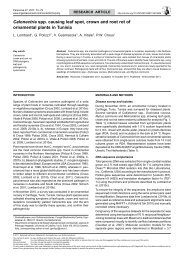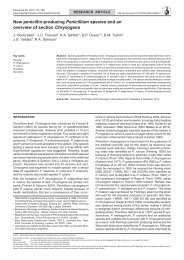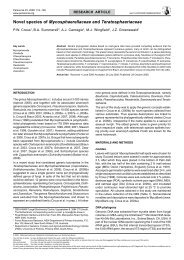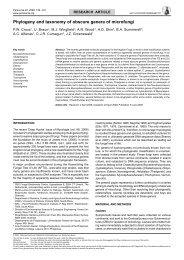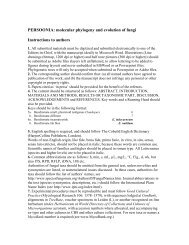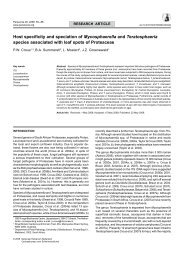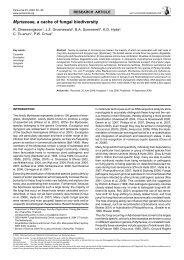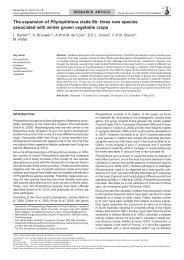Foliicolous microfungi occurring on Encephalartos - Persoonia
Foliicolous microfungi occurring on Encephalartos - Persoonia
Foliicolous microfungi occurring on Encephalartos - Persoonia
You also want an ePaper? Increase the reach of your titles
YUMPU automatically turns print PDFs into web optimized ePapers that Google loves.
Perso<strong>on</strong>ia 21, 2008: 135–146<br />
www.perso<strong>on</strong>ia.org<br />
RESEARCH ARTICLE<br />
doi:10.3767/10.3767/003158508X380612<br />
<str<strong>on</strong>g>Foliicolous</str<strong>on</strong>g> <str<strong>on</strong>g>microfungi</str<strong>on</strong>g> <str<strong>on</strong>g>occurring</str<strong>on</strong>g> <strong>on</strong> <strong>Encephalartos</strong><br />
P.W. Crous 1,2 , A.R. Wood 3 , G. Okada 4 , J.Z. Groenewald 1<br />
Key words<br />
Catenulostroma<br />
Cladophialophora<br />
Dactylaria<br />
ITS nrDNA<br />
LSU nrDNA<br />
Ochroc<strong>on</strong>is<br />
Phaeom<strong>on</strong>iella<br />
Saccharata<br />
systematics<br />
Teratosphaeria<br />
Abstract Species of <strong>Encephalartos</strong>, comm<strong>on</strong>ly known as bread trees, bread palms or cycads are native to Africa;<br />
the genus encompasses more than 60 species and represents an important comp<strong>on</strong>ent of the indigenous African<br />
flora. Recently, a leaf blight disease was noted <strong>on</strong> several E. altensteinii plants growing at the foot of Table Mountain<br />
in the Kirstenbosch Botanical Gardens of South Africa. Preliminary isolati<strong>on</strong>s from dead and dying leaves of E. altensteinii,<br />
E. lebomboensis and E. princeps, collected from South Africa, revealed the presence of several novel<br />
<str<strong>on</strong>g>microfungi</str<strong>on</strong>g> <strong>on</strong> this host. Novelties include Phaeom<strong>on</strong>iella capensis, Saccharata kirstenboschensis, Teratosphaeria<br />
altensteinii and T. encephalarti. New host records of species previously <strong>on</strong>ly known to occur <strong>on</strong> Proteaceae include<br />
Cladophialophora proteae and Catenulostroma microsporum, as well as a hyperparasite, Dactylaria leptosphaeriicola,<br />
<str<strong>on</strong>g>occurring</str<strong>on</strong>g> <strong>on</strong> ascomata of T. encephalarti.<br />
Article info Received: 1 October 2008; Accepted: 14 October 2008; Published: 22 October 2008.<br />
INTRODUCTION<br />
<strong>Encephalartos</strong> (Zamiaceae) is a genus of cycads indigenous<br />
to Africa. Due to its edible pith, species of <strong>Encephalartos</strong> are<br />
comm<strong>on</strong>ly referred to as bread trees or bread palms (www.<br />
kew.org/plants/). Another interesting aspect that makes <strong>Encephalartos</strong><br />
noteworthy is the fact that it could represent <strong>on</strong>e of<br />
the oldest pot-plants in the world. A specimen of E. altensteinii<br />
was collected in the Eastern Cape Province of South Africa in<br />
the early 1770s, and taken to Kew Botanic Gardens in the UK<br />
by Francis Mass<strong>on</strong> in 1775, where it is still to be seen in the<br />
Palm House today. Although this plant genus is endangered<br />
and known to suffer from trunk and root parasites, as well as<br />
fungal infecti<strong>on</strong>s, very few fungi have been described from<br />
this host (Doidge 1950, Nag Raj 1993, nt.ars-grin.gov/fungaldatabases/).<br />
Fungal biodiversity has been poorly studied from most African<br />
countries, which could explain why so few fungal taxa have thus<br />
far been reported from <strong>Encephalartos</strong>. In a recent attempt to<br />
estimate how many species of fungi could occur at the tip of<br />
Africa, Crous et al. (2006a) c<strong>on</strong>cluded that the 1.5 M estimate<br />
suggested by Hawksworth (1991) was clearly too c<strong>on</strong>servative.<br />
Based <strong>on</strong> available data, South Africa al<strong>on</strong>e should have<br />
at least 200 000 fungal species associated with plant species,<br />
without taking into account the number associated with insects,<br />
or other ecological habitats such as water and soil.<br />
Because of its extremely hard, leathery leaves, <str<strong>on</strong>g>microfungi</str<strong>on</strong>g><br />
are not readily observed to col<strong>on</strong>ise foliage of <strong>Encephalartos</strong><br />
species. In January 2008, however, a tip blight disease was<br />
1<br />
CBS Fungal Biodiversity Centre, Uppsalalaan 8, 3584 CT Utrecht, The Netherlands;<br />
corresp<strong>on</strong>ding author e-mail: p.crous@cbs.knaw.nl.<br />
2<br />
Department of Plant Pathology, University of Stellenbosch, P. Bag X1, Matieland<br />
7602, South Africa.<br />
3<br />
ARC – Plant Protecti<strong>on</strong> Research Institute, P. Bag X5017, Stellenbosch<br />
7599, South Africa.<br />
4<br />
Microbe Divisi<strong>on</strong> / Japan Collecti<strong>on</strong> of Microorganisms, RIKEN BioResource<br />
Center, 2-1 Hirosawa, Wako, Saitama 351-0198, Japan.<br />
observed <strong>on</strong> several <strong>Encephalartos</strong> palms growing in the<br />
Kirstenbosch Botanical Gardens of South Africa, as well as<br />
in the KwaZulu-Natal Province. The aim of the present study<br />
was therefore to determine if any <str<strong>on</strong>g>microfungi</str<strong>on</strong>g> could be isolated<br />
from these diseased leaves and also investigate symptomatic<br />
<strong>Encephalartos</strong> leaf samples collected from elsewhere.<br />
MATERIALS AND METHODS<br />
Isolates<br />
Dead <strong>Encephalartos</strong> leaves, or leaves with tip blight symptoms,<br />
were chosen for study. As n<strong>on</strong>e of the collecti<strong>on</strong>s had leaves<br />
that were visibly col<strong>on</strong>ised, leaves were incubated in moist<br />
chambers for up to 2 wk, and inspected daily for fungi. Leaf<br />
pieces bearing ascomata were subsequently soaked in water<br />
for approximately 2 h, after which they were placed in the bottom<br />
of Petri dish lids, with the top half of the dish c<strong>on</strong>taining<br />
2 % malt extract agar (MEA; Oxoid, Hampshire, England).<br />
Ascospore germinati<strong>on</strong> patterns were examined after 24 h,<br />
and single ascospore and c<strong>on</strong>idial cultures established as<br />
described by Crous (1998). Col<strong>on</strong>ies were subcultured <strong>on</strong>to<br />
2 % potato-dextrose agar (PDA), synthetic nutrient-poor agar<br />
(SNA), MEA, and oatmeal agar (OA) (Gams et al. 2007), and<br />
incubated under c<strong>on</strong>tinuous near-ultraviolet light at 25 °C to<br />
promote sporulati<strong>on</strong>. All cultures obtained in this study are<br />
maintained in the culture collecti<strong>on</strong> of the CBS (Table 1).<br />
Nomenclatural novelties and descripti<strong>on</strong>s were deposited in<br />
MycoBank (Crous et al. 2004b).<br />
DNA phylogeny<br />
Genomic DNA was isolated from fungal mycelium grown <strong>on</strong><br />
MEA, using the UltraClean TM Microbial DNA Isolati<strong>on</strong> Kit (Mo<br />
Bio Laboratories, Inc., Solana Beach, CA, USA) according to<br />
the manufacturer’s protocols. The Primers V9G (de Hoog &<br />
Gerrits van den Ende 1998) and LR5 (Vilgalys & Hester 1990)<br />
were used to amplify part of the nuclear rDNA oper<strong>on</strong> spanning<br />
© 2008 Nati<strong>on</strong>aal Herbarium Nederland<br />
Centraalbureau voor Schimmelcultures
136 Perso<strong>on</strong>ia – Volume 21, 2008<br />
Table 1 Collecti<strong>on</strong> details and GenBank accessi<strong>on</strong> numbers for fungal species isolated from <strong>Encephalartos</strong> spp.<br />
Species Strain no. 1 Substrate Collector(s) GenBank Accessi<strong>on</strong> number<br />
ITS 2 LSU 2<br />
Catenulostroma abietis CPC 14996 Dead leaf tissue of E. altensteinii P.W. Crous FJ372387 FJ372404<br />
Cladophialophora proteae CPC 14902 Dead leaf tissue of E. altensteinii P.W. Crous FJ372388 FJ372405<br />
Lophiostoma sp. CPC 15000; CBS 123543 Living leaves of E. altensteinii P.W. Crous et al. FJ372389 FJ372406<br />
Ochroc<strong>on</strong>is sp. CPC 15461; CBS 123536 Living leaves of E. lebomboensis A.R. Wood FJ372390 FJ372407<br />
Phaeom<strong>on</strong>iella capensis CPC 15416; CBS 123535 Living leaves of E. altensteinii A.R. Wood FJ372391 FJ372408<br />
Saccharata kirstenboschensis CPC 15275; CBS 123537 Living leaves of E. princeps A.R. Wood FJ372392 FJ372409<br />
Teratosphaeria altensteinii CPC 15133; CBS 123539 Living leaves of E. altensteinii P.W. Crous et al. FJ372394 FJ372411<br />
Teratosphaeria encephalarti CPC 14886; CBS 123540 Living leaves of E. altensteinii P.W. Crous et al. FJ372395 FJ372412<br />
CPC 15281; CBS 123544 Living leaves of E. altensteinii A.R. Wood FJ372396 FJ372413<br />
CPC 15362; CBS 123541 Living leaves of E. altensteinii A.R. Wood FJ372397 FJ372414<br />
CPC 15413; CBS 123545 Living leaves of E. altensteinii A.R. Wood FJ372398 FJ372415<br />
CPC 15464; CBS 123546 Living leaves of E. lebomboensis A.R. Wood FJ372399 FJ372416<br />
CPC 15465 Living leaves of E. lebomboensis A.R. Wood FJ372400 FJ372417<br />
CPC 15466 Living leaves of E. lebomboensis A.R. Wood FJ372401 FJ372418<br />
Teratosphaeria sp. CPC 14997 Living leaves of E. altensteinii P.W. Crous et al. FJ372402 FJ372419<br />
1<br />
CBS: Centraalbureau voor Schimmelcultures, Utrecht, The Netherlands; CPC: Culture collecti<strong>on</strong> of Pedro Crous, housed at CBS.<br />
2<br />
ITS: Internal transcribed spacers 1 and 2 together with 5.8S nrDNA; LSU: 28S nrDNA.<br />
the 3’ end of the 18S rRNA gene (SSU), the first internal transcribed<br />
spacer (ITS1), the 5.8S rRNA gene, the sec<strong>on</strong>d ITS<br />
regi<strong>on</strong> (ITS2) and the first 900 bases at the 5’ end of the 28S<br />
rRNA gene (LSU). The primers ITS4 (White et al. 1990) and<br />
LR0R (Rehner & Samuels 1994) were used as internal sequence<br />
primers to ensure good quality sequences over the<br />
entire length of the amplic<strong>on</strong>. The PCR c<strong>on</strong>diti<strong>on</strong>s, sequence<br />
alignment and subsequent phylogenetic analysis followed the<br />
methods of Crous et al. (2006b). Alignment gaps were treated<br />
as new character states. Sequence data were deposited in Gen-<br />
Bank (Table 1) and alignments in TreeBASE (www.treebase.<br />
org). The ITS sequences were compared with the sequences<br />
available in NCBIs GenBank nucleotide database using a<br />
megablast search.<br />
Morphology<br />
Col<strong>on</strong>y growth characteristics (surface and reverse) were assessed<br />
<strong>on</strong> MEA, PDA, OA and SNA (Gams et al. 2007), and<br />
colours determined using the colour charts of Rayner (1970).<br />
Microscopic observati<strong>on</strong>s were made from fungal col<strong>on</strong>ies<br />
cultivated <strong>on</strong> different media, as stated with each fungus. Preparati<strong>on</strong>s<br />
were mounted in lactic acid and studied by means of a<br />
light microscope (× 1000 magnificati<strong>on</strong>). Microscopic observati<strong>on</strong>s<br />
were made from hyphomycetes by using the transparent<br />
tape or slide culture technique, as respectively explained by<br />
Schubert et al. (2007) and Arzanlou et al. (2007). The 95 %<br />
c<strong>on</strong>fidence intervals were derived from 30 observati<strong>on</strong>s of<br />
spores formed in culture, with extremes given in parentheses.<br />
All cultures obtained in this study are maintained in the culture<br />
collecti<strong>on</strong> of the Centraalbureau voor Schimmelcultures (CBS)<br />
in Utrecht, the Netherlands, or the working collecti<strong>on</strong> (CPC) of<br />
P.W. Crous (Table 1).<br />
Results<br />
DNA phylogeny<br />
Amplificati<strong>on</strong> products of approximately 1 700 bases were<br />
obtained for the isolates listed in Table 1. The LSU regi<strong>on</strong> of<br />
the sequences was used to obtain additi<strong>on</strong>al sequences from<br />
GenBank, which were added to the alignment. Due to the inclusi<strong>on</strong><br />
of the shorter Phaeom<strong>on</strong>iella chlamydospora (GenBank<br />
AB278179) and Ochroc<strong>on</strong>is ‘humicola’ (GenBank AB161068)<br />
sequences in the alignment, it was not possible to subject<br />
the full length of the determined LSU sequences (Table 1) to<br />
the analyses. The manually adjusted alignment c<strong>on</strong>tained 53<br />
sequences (including the outgroup sequence) and, of the 563<br />
characters used in the phylogenetic analyses, 253 were parsim<strong>on</strong>y-informative,<br />
24 were variable and parsim<strong>on</strong>y-uninformative,<br />
and 286 were c<strong>on</strong>stant. Neighbour-joining analyses using<br />
three substituti<strong>on</strong> models <strong>on</strong> the sequence data yielded trees<br />
supporting the same tree topology to <strong>on</strong>e another but differed<br />
from the most parsim<strong>on</strong>ious tree shown in Fig. 1 with regard to<br />
the placement of the clade c<strong>on</strong>taining Ochroc<strong>on</strong>is and Fusicladium<br />
(in the distance analyses, this clade moves to a more basal<br />
positi<strong>on</strong>). Forty equally most parsim<strong>on</strong>ious trees (TL = 1039<br />
steps, CI = 0.477, RI = 0.833, RC = 0.397), <strong>on</strong>e of which is<br />
shown in Fig. 1, were obtained from the parsim<strong>on</strong>y analysis<br />
of the LSU alignment. The isolates from <strong>Encephalartos</strong> are<br />
distributed across several families and orders and tax<strong>on</strong>omic<br />
novelties are described below and specific taxa are highlighted<br />
in the Discussi<strong>on</strong>. Results obtained from the BLAST searches<br />
of the ITS sequences are discussed where applicable.<br />
Tax<strong>on</strong>omy<br />
Several species of fungi which are believed to be new were<br />
collected, and are described in genera such as Phaeom<strong>on</strong>iella,<br />
Saccharata and Teratosphaeria. New records for <strong>Encephalartos</strong><br />
include Catenulostroma microsporum, Cladophialophora proteae,<br />
Dactylaria leptosphaeriicola, and undescribed species of<br />
Teratosphaeria, Lophiostoma and Ochroc<strong>on</strong>is.
P.W. Crous et al.: <str<strong>on</strong>g>Foliicolous</str<strong>on</strong>g> <str<strong>on</strong>g>microfungi</str<strong>on</strong>g> <str<strong>on</strong>g>occurring</str<strong>on</strong>g> <strong>on</strong> <strong>Encephalartos</strong><br />
137<br />
10 changes<br />
Fig. 1 One of 40 equally most parsim<strong>on</strong>ious trees obtained from a<br />
heuristic search with 100 random tax<strong>on</strong> additi<strong>on</strong>s of the LSU sequence<br />
alignment. The scale bar shows 10 changes, and bootstrap support<br />
values (>70 %) from 1 000 replicates are shown at the nodes. Isolates<br />
from <strong>Encephalartos</strong> are shown in bold. The tree was rooted to a sequence<br />
of Nectria pseudotrichia (GenBank accessi<strong>on</strong> AY288102).<br />
Nectria pseudotrichia AY288102<br />
100<br />
Graphiopsis chlorocephala EU009458<br />
Verrucocladosporium dirinae EU040244<br />
Toxicocladosporium irritans EU040243<br />
89 Toxicocladosporium sp. FJ372420<br />
99<br />
100 Davidiella macrospora EF679369<br />
Cladosporium sphaerospermum DQ780351<br />
100 Catenulostroma abietis EU019249<br />
Catenulostroma abietis CPC 14996<br />
100 Penidiella rigidophora EU019276<br />
Teratosphaeria bellula EU019301<br />
Catenulostroma chromoblastomycosum EU019251<br />
Teratosphaeria sp. CPC 14997<br />
Colletogloeopsis gauchensis EU019290<br />
Teratosphaeria encephalarti CPC 15465<br />
Teratosphaeria encephalarti CPC 15464<br />
92<br />
Teratosphaeria encephalarti CPC 15413<br />
Teratosphaeria encephalarti CPC 15281<br />
Teratosphaeria encephalarti CPC 15466<br />
Teratosphaeria altensteinii CPC 15133<br />
Teratosphaeria encephalarti CPC 14886<br />
Teratosphaeria encephalarti CPC 15362<br />
81<br />
100<br />
75<br />
100<br />
86<br />
Glyphium elatum AF346420<br />
100 100<br />
86<br />
79 100<br />
77<br />
94<br />
100<br />
Cladophialophora proteae CPC 14902<br />
Cladophialophora proteae EU035411<br />
Exophiala placitae EU040215<br />
Phaeococcomyces catenatus AF050277<br />
Rhynchostoma proteae EU552154<br />
Phaeom<strong>on</strong>iella chlamydospora AB278179<br />
Phaeom<strong>on</strong>iella capensis CPC 15416<br />
Verrucaria muralis EF643803 Verrucariales<br />
Capr<strong>on</strong>ia villosa AF050261 Chaetothyriales II<br />
72 Amorphotheca resinae EU030277 incertae sedis<br />
Lasallia pustulata AY300839 Umbilicariales<br />
100 Ochroc<strong>on</strong>is “humicola” AB161068<br />
Ochroc<strong>on</strong>is sp. CPC 15461<br />
incertae sedis<br />
100<br />
100<br />
100<br />
Fusicladium rhodense EU035440<br />
Fusicladium ramoc<strong>on</strong>idii EU035439<br />
Fusicladium pini EU035436<br />
100 Lophiostoma sp. CPC 15000<br />
Lophiostoma fuckelii EU552139<br />
Phaeosphaeriopsis musae DQ885894<br />
Sclerostag<strong>on</strong>ospora opuntiae DQ286772<br />
Sclerostag<strong>on</strong>ospora sp. FJ372410<br />
Phaeosphaeria avenaria f. sp. avenaria EU223257<br />
Phaeosphaeria nodorum EF590318<br />
Dichomera eucalypti DQ377887<br />
Tiarosporella madreeya DQ377940<br />
Macrophomina phaseolina DQ678088<br />
Aplosporella sp. EU931110<br />
88<br />
Capnodiales<br />
Saccharata proteae DQ377882<br />
Saccharata kirstenboschensis CPC 15275<br />
Saccharata capensis EU552129<br />
Pleosporales I<br />
Botryosphaeriales<br />
Chaetothyriales I<br />
incertae sedis<br />
Pleosporales II<br />
Phaeom<strong>on</strong>iella capensis Crous & A.R. Wood, sp. nov. —<br />
MycoBank MB508007; Fig. 2<br />
Phaeom<strong>on</strong>iellae chlamydosporae similis, sed c<strong>on</strong>idiis majoribus, (2–)3(–4)<br />
× 1–1.5 µm.<br />
Etymology. Name refers to the Cape Province of South Africa, where this<br />
fungus was collected.<br />
On SNA. Mycelium c<strong>on</strong>sisting of septate, branched, hyaline<br />
to pale brown, thick-walled hyphae, 1.5–2 µm; developing<br />
hyaline, thin-walled, swollen, globose structures. C<strong>on</strong>idiomata<br />
pycnidial to acervular, opening by irregular rupture, erumpent,<br />
brown, up to 250 µm diam; wall of 3–6 layers of brown textura<br />
angularis. C<strong>on</strong>idiophores hyaline, smooth, highly variable in<br />
morphology, <str<strong>on</strong>g>occurring</str<strong>on</strong>g> in branched structures, 2–4-septate,<br />
or solitary, ampulliform, reduced to phialides. C<strong>on</strong>idiogenous<br />
cells 3–10 × 2–3 µm; apical opening with minute periclinal<br />
thickening. C<strong>on</strong>idia hyaline, smooth, narrowly ellipsoid, straight,<br />
(2–)3(–4) × 1–1.5 µm.<br />
Cultural characteristics — Col<strong>on</strong>ies erumpent, spreading,<br />
lacking aerial mycelium, slimy, with folded surface and smooth,<br />
catenulate margin; <strong>on</strong> PDA salm<strong>on</strong> with patches of apricot,<br />
and apricot in reverse, reaching 10 mm diam after 1 mo; <strong>on</strong><br />
OA salm<strong>on</strong> to flesh with brown patches due to c<strong>on</strong>idiomatal<br />
formati<strong>on</strong>, reaching 12 mm diam after 1 mo; <strong>on</strong> MEA salm<strong>on</strong>
138 Perso<strong>on</strong>ia – Volume 21, 2008<br />
a<br />
b<br />
c<br />
d<br />
e<br />
Fig. 2 Phaeom<strong>on</strong>iella capensis in vitro (CBS 123535). a. Col<strong>on</strong>y <strong>on</strong> OA; b. col<strong>on</strong>y <strong>on</strong> PDA; c, d. c<strong>on</strong>idiogenous cells and c<strong>on</strong>idia; e. c<strong>on</strong>idia. — Scale bar<br />
= 10 µm.<br />
with patches of apricot and flesh, apricot in reverse, reaching<br />
15 mm diam after 1 mo.<br />
Specimen examined. South Africa, Western Cape Province, Kirstenbosch<br />
Botanical Garden, <strong>on</strong> living leaves of <strong>Encephalartos</strong> altensteinii, 22 May 2008,<br />
A.R. Wood, CBS H-20159, culture ex-type CPC 15416 = CBS 123535, CPC<br />
15417–15418.<br />
Notes — Two fungal species that have previously been described<br />
from <strong>Encephalartos</strong> need to be compared with P. capensis.<br />
Leptothyrium evansii forms hypophylous pycnidia with<br />
obl<strong>on</strong>g, hyaline c<strong>on</strong>idia, 3.5–5 × 1.5–2 µm, thus larger than<br />
observed in P. capensis (Sydow & Sydow 1912). The sec<strong>on</strong>d<br />
species, Phoma encephalarti, is distinct in having larger, biguttulate<br />
c<strong>on</strong>idia, 6.3–7.2 × 2.7–3.6 µm (Negodi 1932).<br />
The fact that the present collecti<strong>on</strong> clusters in Phaeom<strong>on</strong>iella<br />
(hyphomycetous genus) is somewhat surprising. However, this<br />
genus also has a phoma-like synanamorph and a yeast-like<br />
growth in culture (Crous & Gams 2000), similar to P. capensis.<br />
Although further collecti<strong>on</strong>s may eventually show this complex<br />
to represent more than <strong>on</strong>e genus, we presently c<strong>on</strong>sider it best<br />
to place the <strong>Encephalartos</strong> fungus in Phaeom<strong>on</strong>iella based <strong>on</strong><br />
current data. BLAST results of the ITS sequence revealed an<br />
identity of 89 % with Phaeom<strong>on</strong>iella chlamydospora (GenBank<br />
accessi<strong>on</strong> AY772237).<br />
Saccharata kirstenboschensis Crous & A.R. Wood, sp. nov.<br />
— MycoBank MB508008; Fig. 3<br />
Saccharatae proteae similis, sed c<strong>on</strong>idiis minoribus, (16–)18–22(–24) ×<br />
3.5–4(–5) μm.<br />
Etymology. Name refers to Kirstenbosch Botanical Gardens, South Africa,<br />
where this fungus was collected.<br />
On WA with sterile pine needles. C<strong>on</strong>idiomata pycnidial, black,<br />
up to 350 µm diam, with a single, central ostiole; wall c<strong>on</strong>sisting<br />
of 2–3 layers of brown textura angularis. C<strong>on</strong>idiophores<br />
subcylindrical, hyaline, smooth, frequently reduced to c<strong>on</strong>idiogenous<br />
cells or branched in apical part, 1–2-septate, 10–45<br />
× 2–3.5 µm. C<strong>on</strong>idiogenous cells terminal, subcylindrical,<br />
hyaline, 15–20 × 2–3 µm; apex with periclinal thickening, or<br />
with 1–3 percurrent proliferati<strong>on</strong>s. Paraphyses intermingled<br />
am<strong>on</strong>g c<strong>on</strong>idiophores, at times arising as lateral branches from<br />
c<strong>on</strong>idiophores, or separate, unbranched or branched above,<br />
hyaline, smooth, 0–3-septate, 2–3 µm wide, extending above<br />
c<strong>on</strong>idiophores. C<strong>on</strong>idia hyaline, smooth, fusiform to narrowly<br />
ellipsoid, apex subobtuse, base truncate with minute marginal<br />
frill, guttulate, thin-walled, (16–)18–22(–24) × 3.5–4(–5) μm,<br />
base 2–3 µm wide.
P.W. Crous et al.: <str<strong>on</strong>g>Foliicolous</str<strong>on</strong>g> <str<strong>on</strong>g>microfungi</str<strong>on</strong>g> <str<strong>on</strong>g>occurring</str<strong>on</strong>g> <strong>on</strong> <strong>Encephalartos</strong><br />
139<br />
a<br />
b<br />
c<br />
d<br />
e<br />
Fig. 3 Saccharata kirstenboschensis in vitro (CBS 123537). a. C<strong>on</strong>idiomata <strong>on</strong> WA with sterile pine needles; b, c. c<strong>on</strong>idiogenous cells giving rise to c<strong>on</strong>idia;<br />
d. c<strong>on</strong>idium attached to c<strong>on</strong>idiogenous cell; e, f. c<strong>on</strong>idia. — Scale bars = 10 µm.<br />
f<br />
Cultural characteristics — Col<strong>on</strong>ies <strong>on</strong> MEA, PDA and OA<br />
spreading, erumpent, with moderate aerial mycelium and uneven,<br />
catenulate margins; pale olivaceous-grey with patches<br />
of grey and olivaceous-grey; reverse olivaceous-grey; reaching<br />
6 cm diam after 1 mo.<br />
Specimen examined. South Africa, Western Cape Province, Kirstenbosch<br />
Botanical Garden, <strong>on</strong> living leaves of <strong>Encephalartos</strong> princeps, 22 May 2008,<br />
A.R. Wood, holotype CBS H-20160, culture ex-type CPC 15275 = CBS<br />
123537, CPC 15276–15277.<br />
Notes — The genus Saccharata presently c<strong>on</strong>sists of two<br />
species, namely S. proteae (c<strong>on</strong>idia 20–30 × 4.5–6 μm; Denman<br />
et al. 1999, Crous et al. 2006b) and S. capensis (c<strong>on</strong>idia<br />
13–18 × 3.5–5.5 μm; Marincowitz et al. 2008). Saccharata<br />
kirstenboschensis represents an intermediate species, having<br />
c<strong>on</strong>idia 16–24 × 3.5–5 μm. Furthermore, it is the first species<br />
of Saccharata known to occur <strong>on</strong> a host other than Proteaceae,<br />
although all taxa described thus far appear to be endemic to<br />
South Africa. BLAST results of the ITS sequence revealed an<br />
identity of 98 % with S. proteae (GenBank accessi<strong>on</strong> EU552145;<br />
819 of 830 bases) and S. capensis (GenBank accessi<strong>on</strong><br />
EU552130; 803 of 816 bases).<br />
Teratosphaeria altensteinii Crous, sp. nov. — MycoBank<br />
MB508010; Fig. 4<br />
Teratosphaeriae bellulae similis, sed ascosporis minoribus, 7–8(–9) ×<br />
2.5–3(–3.5) µm.<br />
Etymology. Name refers to its host species, <strong>Encephalartos</strong> altensteinii.<br />
Leaves with tip-blight symptoms; necrotic tissue grey-brown,<br />
separated from healthy tissue by a narrow, dark-brown border.<br />
Ascomata hypophyllous, black, immersed, substomatal, up to<br />
90 µm diam; ostiole lined with periphyses; wall c<strong>on</strong>sisting of 2–3<br />
layers of medium brown textura angularis. Asci aparaphysate,<br />
fasciculate, bitunicate, subsessile, obovoid, straight to slightly<br />
curved, 8-spored, 35–37 × 8–9 µm. Ascospores bi- to triseriate,<br />
overlapping, hyaline, guttulate, thin-walled, straight, fusoidellipsoidal<br />
with obtuse ends, widest in middle of apical cell,<br />
prominently c<strong>on</strong>stricted at the septum, tapering towards both<br />
ends, but more prominently towards the lower end, 7–8(–9)<br />
× 2.5–3(–3.5) µm; germinating ascospores <strong>on</strong> MEA become<br />
brown and verruculose, germinating with multiple germ tubes<br />
irregular to the l<strong>on</strong>g axis of the spore, c<strong>on</strong>stricted at septum<br />
and distorting, up to 8 µm wide.
140 Perso<strong>on</strong>ia – Volume 21, 2008<br />
c<br />
a<br />
b<br />
d<br />
e<br />
f<br />
g<br />
Fig. 4 Teratosphaeria altensteinii in vitro (CBS 123539). a, b. Asci; c, d. ascospores; e–g. germinating ascospores <strong>on</strong> MEA. — Scale bars = 10 µm.<br />
Cultural characteristics — Col<strong>on</strong>ies <strong>on</strong> MEA spreading,<br />
somewhat erumpent, with moderate aerial mycelium, and even,<br />
catenulate margins; surface ir<strong>on</strong>-grey; reverse greenish black;<br />
reaching 20 mm diam after 1 mo; <strong>on</strong> PDA and OA similar, but<br />
olivaceous-grey <strong>on</strong> surface, and ir<strong>on</strong>-grey in reverse; <strong>on</strong> MEA<br />
and PDA hyphae form terminal clusters of chlamydosporelike<br />
cells, which are catenulostroma-like in appearance, and<br />
frequently detach under squash mounts.<br />
Specimen examined. South Africa, Western Cape Province, Kirstenbosch<br />
Botanical Garden, <strong>on</strong> living leaves of <strong>Encephalartos</strong> altensteinii, 6 Jan. 2008,<br />
P.W. Crous, M.K. Crous, M. Crous & K. Raath, holotype CBS H-20162, culture<br />
ex-type CPC 15133 = CBS 123539, CPC 15134–15135.<br />
Notes — Teratosphaeria altensteinii is phylogenetically closely<br />
related to T. bellula (593 of 601 bases when the ITS sequence<br />
is compared to GenBank accessi<strong>on</strong> EU707861), which is a<br />
pathogen of Proteaceae (Crous & Wingfield 1993, Crous et al.<br />
2004a, 2008). Morphologically it has ascospores that are similar<br />
in shape, but are distinct in that they lack a prominent sheath<br />
and are somewhat smaller (7–9 × 2.5–3.5 µm) than those of<br />
T. bellula (8–11 × 2–3.5 µm; Crous & Wingfield 1993).<br />
Teratosphaeria encephalarti Crous & A.R. Wood, sp. nov.<br />
— MycoBank MB508011; Fig. 5<br />
Anamorph. Penidiella sp.<br />
Teratosphaeriae bellulae similis, sed ascosporis majoribus, (9–)10–11(–14)<br />
× (3–)3.5–4 µm.<br />
Etymology. Name refers to its host genus, <strong>Encephalartos</strong>.<br />
Leaves with tip-blight symptoms; nectrotic tissue grey-brown.<br />
Ascomata hypophyllous, black, immersed, substomatal, up to<br />
90 µm diam; ostiole lined with periphyses; wall c<strong>on</strong>sisting of 2–3<br />
layers of medium brown textura angularis. Asci aparaphysate,<br />
fasciculate, bitunicate, subsessile, obovoid to broadly ellipsoid,<br />
straight to curved, 8-spored, 30–40 × 10–13 µm. Pseudoparaphyses<br />
intermingled am<strong>on</strong>g asci, branched, septate, hyaline,<br />
2–3 µm wide. Ascospores bi- to triseriate, overlapping, hyaline,<br />
guttulate, thin-walled, straight, fusoid-ellipsoidal with obtuse<br />
ends, widest in middle of apical cell, prominently c<strong>on</strong>stricted at<br />
the septum, tapering towards both ends, but more prominently<br />
towards the lower end, (9–)10–11(–14) × (3–)3.5–4 µm; turning<br />
brown and verruculose in older asci; germinating ascospores <strong>on</strong>
P.W. Crous et al.: <str<strong>on</strong>g>Foliicolous</str<strong>on</strong>g> <str<strong>on</strong>g>microfungi</str<strong>on</strong>g> <str<strong>on</strong>g>occurring</str<strong>on</strong>g> <strong>on</strong> <strong>Encephalartos</strong><br />
141<br />
a<br />
b<br />
c<br />
f<br />
h<br />
j<br />
d<br />
e<br />
g<br />
i<br />
k<br />
l<br />
m<br />
Fig. 5 Teratosphaeria encephalarti (CBS 123540). a. Diseased <strong>Encephalartos</strong> altensteinii palms in Kirstenbosch Botanical Gardens, South Africa; b. leaf<br />
blight symptoms; c. ascomata <strong>on</strong> leaves (arrows); d, e. asci; f. ascospores; g–k. germinating ascospores <strong>on</strong> MEA; l–o. Penidiella anamorph with branched<br />
c<strong>on</strong>idial chains. — Scale bars = 10 µm.<br />
n<br />
o
142 Perso<strong>on</strong>ia – Volume 21, 2008<br />
MEA become brown and verruculose, germinating with several<br />
germ tubes irregular to the l<strong>on</strong>g axis of the spore, c<strong>on</strong>stricted at<br />
septum and distorting, up to 7 µm wide. On OA. Mycelium c<strong>on</strong>sisting<br />
of creeping, branched, septate, brown, smooth, 2–3.5<br />
µm wide hyphae. C<strong>on</strong>idiophores solitary, erect, subcylindrical,<br />
arising from creeping hyphae, medium brown, thick-walled,<br />
smooth to finely verruculose, 1–6-septate, 15–50 × 3–4.5 µm.<br />
C<strong>on</strong>idiogenous cells terminal, subcylindrical, medium brown,<br />
smooth, up to 4 µm wide; scars somewhat thickened and<br />
darkened, up to 2.5 µm wide. Ramoc<strong>on</strong>idia 0–1-septate,<br />
subcylindrical to el<strong>on</strong>gate-ellipsoid, medium brown, smooth,<br />
thick-walled, with 1–3 apical loci, 10–15 × 3–4 µm. Sec<strong>on</strong>dary<br />
ramoc<strong>on</strong>idia 0–1-septate, narrowly ellipsoid, 7–10 × 3–3.5 µm.<br />
Intercalary c<strong>on</strong>idia in chains of up to 15, aseptate, fusoidellipsoid,<br />
medium brown, smooth, (5–)6–7(–8) × 2–3(–2.5)<br />
µm. Terminal c<strong>on</strong>idia aseptate, ellipsoid, pale to medium brown,<br />
with truncate base, 3–4 × 2–3 µm; hila slightly thickened and<br />
darkened, 0.5–1 µm wide.<br />
Cultural characteristics — Col<strong>on</strong>ies <strong>on</strong> OA, MEA and PDA<br />
spreading with moderate aerial mycelium and smooth, catenulate<br />
margins; centre olivaceous-grey, outer regi<strong>on</strong> and reverse<br />
ir<strong>on</strong>-grey; reaching 30 mm diam after 1 mo.<br />
Specimens examined. South Africa, Western Cape Province, Kirstenbosch<br />
Botanical Garden, <strong>on</strong> living leaves of <strong>Encephalartos</strong> altensteinii, 6 Jan.<br />
2008, P.W. Crous, M.K. Crous, M. Crous & K. Raath, holotype CBS H-20163,<br />
culture ex-type CPC 14886 = CBS 123540, CPC 14887–14888; 22 May<br />
2008, A.R. Wood, culture CPC 15413 = CBS 123545, CPC 15414–15415;<br />
CPC 15362 = CBS 123541, CPC 15363–15364; CPC 15281 = CBS 123544,<br />
CPC 15282–15283; KwaZulu-Natal, South Coast, Uv<strong>on</strong>go, Skyline Nature<br />
Reserve, arboretum, living leaves of <strong>Encephalartos</strong> lebomboensis, 29 May<br />
2008, A.R. Wood, culture CPC 15464 = CBS 123546, CPC 15465–15466.<br />
Notes — Teratosphaeria encephalarti appeared to be quite<br />
dominant <strong>on</strong> the dying leaves of E. altensteinii in the Western<br />
Cape Province and it is possible that this species plays a role in<br />
the recently observed leaf blight disease. Inoculati<strong>on</strong> studies are<br />
required, however, to c<strong>on</strong>firm its potential role in this disease.<br />
Phylogenetically T. encephalarti and T. altensteinii are distantly<br />
related (88 % based <strong>on</strong> ITS) to T. associata, which occurs <strong>on</strong><br />
Eucalyptus and Protea spp. (Crous et al. 2007a, 2008). The ITS<br />
sequences of the ex-type strains of T. altensteinii and T. encephalarti<br />
have an identity of 91 % with each other (430 of 468<br />
bases).<br />
Undetermined species<br />
Lophiostoma sp.<br />
Cultural characteristics — Col<strong>on</strong>ies <strong>on</strong> MEA, PDA and OA<br />
spreading with moderate aerial mycelium, and smooth, catenulate<br />
margins; surface olivaceous-grey; reverse ir<strong>on</strong>-grey;<br />
reaching 25 mm diam after 1 mo.<br />
Specimen examined. South Africa, Western Cape Province, Kirstenbosch<br />
Botanical Garden, <strong>on</strong> living leaves of <strong>Encephalartos</strong> altensteinii, 6 Jan. 2008,<br />
P.W. Crous, M.K. Crous, M. Crous & K. Raath, culture CPC 15000 = CBS<br />
123543, CPC 15001–15002.<br />
Notes — Isolate CBS 123543 is representative of a species<br />
of Lophiostoma (based <strong>on</strong> ITS DNA sequence similarity to<br />
L. macrostomum GenBank accessi<strong>on</strong> EU552140). It could not<br />
be described, however, due to paucity of material. Ascospores<br />
remained hyaline up<strong>on</strong> germinati<strong>on</strong> <strong>on</strong> MEA, but distort prominently<br />
(up to 10 µm wide), becoming c<strong>on</strong>stricted, with germ<br />
tubes growing down into the agar.<br />
Ochroc<strong>on</strong>is sp. — Fig. 6<br />
On OA. Col<strong>on</strong>ies moderately fast-growing, flat with predominantly<br />
submerged mycelium. Mycelium c<strong>on</strong>sisting of branched,<br />
septate, hyaline to pale brown, smooth, 2–2.5 µm wide hyphae.<br />
C<strong>on</strong>idiophores erect, arising from creeping hyphae, unbranched,<br />
1–6-septate, straight to flexuous, brown, thick-walled, 10–50 ×<br />
2.5–3.5 µm. C<strong>on</strong>idiogenous cells terminal, integrated, 10–35<br />
µm l<strong>on</strong>g, polyblastic, cylindrical, straight to flexuous, pale to<br />
medium brown, with scattered pimple-shaped, subhyaline<br />
denticles, 0.5 µm wide and l<strong>on</strong>g. C<strong>on</strong>idia (5–)7–9(–10) ×<br />
(2.5–)3(–3.5) µm, solitary, subhyaline, smooth to verruculose,<br />
1-septate, thin-walled, obovoid to fusiform, apex subobtuse,<br />
base narrowly truncate with minute marginal frill, 0.5 µm wide;<br />
c<strong>on</strong>idial secessi<strong>on</strong> rhexolytic.<br />
Cultural characteristics — Col<strong>on</strong>ies <strong>on</strong> MEA, PDA and OA<br />
spreading, flat, with even, smooth margins, and sparse aerial<br />
mycelium; surface olivaceous-grey, reverse ir<strong>on</strong>-grey; col<strong>on</strong>ies<br />
reaching 25 mm diam after 1 mo.<br />
Specimen examined. South Africa, KwaZulu-Natal, South Coast, Uv<strong>on</strong>go,<br />
Skyline Nature Reserve, arboretum, living leaves of <strong>Encephalartos</strong> lebomboensis,<br />
29 May 2008, A.R. Wood, culture CPC 15461 = CBS 123536, CPC<br />
15462–15463.<br />
Notes — Species of Ochroc<strong>on</strong>is are known to infect cold<br />
blooded vertebrates, or to occur as saprobes <strong>on</strong> different plant<br />
substrates and in soil (de Hoog et al. 2000), suggesting that<br />
the species from <strong>Encephalartos</strong> is probably saprobic. Phylogenetically<br />
the present collecti<strong>on</strong> clusters with a strain identified<br />
as Ochroc<strong>on</strong>is humicola (CBS 780.83), though c<strong>on</strong>idia of the<br />
ex-type strain of O. humicola (CBS 116655) are larger and it<br />
clusters distant from these strains. Preliminary DNA sequence<br />
data suggest that many species of Ochroc<strong>on</strong>is in fact represent<br />
species complexes, and hence it would be best to treat the<br />
<strong>Encephalartos</strong> collecti<strong>on</strong> as part of a generic revisi<strong>on</strong> (de Hoog<br />
et al. in prep).<br />
Teratosphaeria sp.<br />
Cultural characteristics — Col<strong>on</strong>ies <strong>on</strong> MEA, PDA and OA<br />
erumpent, fluffy, with abundant aerial mycelium and even,<br />
catenulate margins; surface olivaceous-grey with patches of<br />
ir<strong>on</strong>-grey and pale olivaceous-grey; reverse ir<strong>on</strong>-grey; reaching<br />
30 mm diam after 1 mo.<br />
Specimen examined. South Africa, Western Cape Province, Kirstenbosch<br />
Botanical Garden, <strong>on</strong> living leaves of <strong>Encephalartos</strong> altensteinii, 6 Jan. 2008,<br />
P.W. Crous, M.K. Crous, M. Crous & K. Raath, culture CPC 14997–14999.<br />
Notes — Isolate CPC 14997 could not be described due to<br />
paucity of material. Based <strong>on</strong> the DNA similarity to an ITS sequence<br />
of Batcheloromyces leucadendri (accessi<strong>on</strong> EU552103;<br />
739 of 801 bases identity) deposited in GenBank, however, it<br />
appears to represent a species of Teratosphaeria. Ascospores<br />
germinated from both polar ends with germ tubes growing parallel<br />
to the l<strong>on</strong>g axis of the spore. Germinating spores became
P.W. Crous et al.: <str<strong>on</strong>g>Foliicolous</str<strong>on</strong>g> <str<strong>on</strong>g>microfungi</str<strong>on</strong>g> <str<strong>on</strong>g>occurring</str<strong>on</strong>g> <strong>on</strong> <strong>Encephalartos</strong><br />
143<br />
a<br />
b<br />
c<br />
d<br />
e<br />
f<br />
g h i j k<br />
Fig. 6 Ochroc<strong>on</strong>is sp. in vitro (CBS 123536). a, b. C<strong>on</strong>idial fascicles <strong>on</strong> MEA with light from above and below, respectively; c–j. c<strong>on</strong>idiophores giving rise to<br />
c<strong>on</strong>idia, with visible denticles (arrows); k. c<strong>on</strong>idia. — Scale bars = 10 µm.<br />
prominently c<strong>on</strong>stricted and distorted, up to 7 µm wide, pale<br />
brown, and somewhat verruculose.<br />
Discussi<strong>on</strong><br />
Prior to the present study <strong>on</strong>ly four fungal species had been described<br />
from <strong>Encephalartos</strong>, namely Leptothyrium evansii, Pestalotia<br />
encephalartos, Phoma encephalarti and Phyllosticta<br />
encephalarti (http://nt.ars-grin.gov/fungaldatabases/). A very<br />
preliminary examinati<strong>on</strong> of four collecti<strong>on</strong>s during the present<br />
study has added a further four species in genera such as Phaeom<strong>on</strong>iella,<br />
Saccharata and Teratosphaeria. Furthermore, due to<br />
paucity of fungal material, several other species remain to be<br />
described in future studies. At present n<strong>on</strong>e of these fungi are<br />
c<strong>on</strong>firmed as being pathogenic, and further work is required to<br />
determine which species are pathogens of <strong>Encephalartos</strong> and<br />
what impact they have <strong>on</strong> the populati<strong>on</strong> dynamics of these<br />
plant species. C<strong>on</strong>sidering that many of these cycad species<br />
are endangered this could have important c<strong>on</strong>sequences for<br />
their c<strong>on</strong>servati<strong>on</strong>.<br />
What is interesting to note, however, is that some species known<br />
from indigenous Proteaceae were also observed for the first<br />
time <strong>on</strong> <strong>Encephalartos</strong>. Dactylaria leptosphaeriicola (Fig. 7)<br />
was initially described as a hyperparasite of ascomata of<br />
Leptosphaeria protearum <strong>on</strong> leaves of Protea repens. It is<br />
interesting that this fungus was found <str<strong>on</strong>g>occurring</str<strong>on</strong>g> <strong>on</strong> ascomata<br />
of Teratosphaeria encephalarti <strong>on</strong> <strong>Encephalartos</strong> altensteinii in<br />
the present study. As found by Braun & Crous (1992), c<strong>on</strong>idia<br />
of this species failed to germinate <strong>on</strong> MEA or PDA, stressing<br />
its close hyperparasitic relati<strong>on</strong>ship with its ascomycetous host.<br />
It is possible, however, that D. leptosphaeriicola is not a true<br />
member of Dactylaria, but represents yet another undescribed<br />
genus resembling Dactylaria in morphology. To c<strong>on</strong>firm this,<br />
however, DNA will have to be isolated from fresh collecti<strong>on</strong>s,
144 Perso<strong>on</strong>ia – Volume 21, 2008<br />
a<br />
b<br />
c d e<br />
Fig. 7 Dactylaria leptosphaeriicola in vivo. a. C<strong>on</strong>idial fascicles <strong>on</strong> leaf; b. c<strong>on</strong>idiogenous cells giving rise to c<strong>on</strong>idia; c–e. c<strong>on</strong>idia. — Scale bars = 10 µm.<br />
a<br />
b<br />
c<br />
d<br />
e<br />
Fig. 8 Cladophialophora proteae in vitro (CPC 14902). a–c. Col<strong>on</strong>y <strong>on</strong> MEA, OA and PDA, respectively; d, e. c<strong>on</strong>idial chains. — Scale bar = 10 µm.
P.W. Crous et al.: <str<strong>on</strong>g>Foliicolous</str<strong>on</strong>g> <str<strong>on</strong>g>microfungi</str<strong>on</strong>g> <str<strong>on</strong>g>occurring</str<strong>on</strong>g> <strong>on</strong> <strong>Encephalartos</strong><br />
145<br />
which would be difficult, as fascicles occur in c<strong>on</strong>juncti<strong>on</strong> with<br />
ascomata of other fungi, and attempts to cultivate the fungus<br />
have thus far proven to be unsuccessful.<br />
Cladophialophora proteae was initially isolated from lesi<strong>on</strong>s of<br />
Batcheloromyces proteae <strong>on</strong> Protea cynaroides, to which it was<br />
assumed to be pathogenic, though no inoculati<strong>on</strong> tests have<br />
ever been c<strong>on</strong>ducted to c<strong>on</strong>firm this hypothesis (Swart et al.<br />
1998). The status of Cladophialophora and Pseudocladosporium<br />
has been an issue of debate, and as Cladophialophora<br />
was used for taxa pathogenic to humans, Crous et al. (2004a)<br />
allocated the species isolated from Protea to Pseudocladosporium.<br />
However, as shown in a subsequent molecular study<br />
(Crous et al. 2007b), Pseudocladosporium is a syn<strong>on</strong>ym of<br />
Fusicladium (Venturiaceae) while species of Cladophialophora<br />
(Herpotrichiellaceae) were shown to occur <strong>on</strong> humans and plant<br />
hosts, and thus the name Cladophialophora proteae can be<br />
used for this fungus (Fig. 8). The fact that this species could also<br />
occur <strong>on</strong> dead leaf tissue of <strong>Encephalartos</strong> altensteinii (CPC<br />
14902–14904) in the Western Cape Province is surprising,<br />
however, and again questi<strong>on</strong>s its possible ecological role and<br />
its potential wider host range.<br />
The link of ‘Trimmatostroma’ to ‘Mycosphaerella’ was first reported<br />
<strong>on</strong> leaf spots of Teratosphaeria maculiformis from Protea<br />
cynaroides leaves collected in South Africa by Taylor & Crous<br />
(2000). After initial data suggesting that Teratosphaeria and<br />
Mycosphaerella represented a single genus (Taylor et al. 2003),<br />
a subsequent study dem<strong>on</strong>strated that these were in fact from<br />
two different families and that species of Teratosphaeria bel<strong>on</strong>ged<br />
to the Teratosphaeriaceae, in which the anamorph genus<br />
Catenulostroma was established for these trimmatostroma-like<br />
anamorphs (Crous et al. 2007a). Within Catenulostroma there is<br />
a species complex surrounding C. abietis, which based <strong>on</strong> DNA<br />
sequence data solely of the ITS gene regi<strong>on</strong>, is very difficult<br />
to distinguish. It is quite possible, therefore, that the <strong>Encephalartos</strong><br />
isolates (CPC 14996), although phylogenetically similar<br />
to Catenulostroma microsporum (Teratosphaeria microspora),<br />
may very well still be shown to represent yet another cryptic<br />
species in this complex.<br />
Africa is well known to have a high level of botanical diversity. As<br />
shown here after an initial cursory look at a few <strong>Encephalartos</strong><br />
leaves, these plants were found to host numerous undescribed<br />
species of fungi. Given the high level of endemism found in<br />
African flora, it can be expected that an equally high number<br />
of these fungal species will be unique species. Unfortunately,<br />
indigenous African fungal biodiversity has never been regarded<br />
as a research priority and as such this research topic has never<br />
been well supported financially. Given the current importance<br />
placed <strong>on</strong> ecotourism and the preservati<strong>on</strong> of unique African<br />
flora and fauna, it is clearly timely that more research focus<br />
and financial resources be channelled towards documenting,<br />
studying ecological roles and impacts, and c<strong>on</strong>serving African<br />
mycoflora.<br />
Acknowledgements Mrs Marjan Vermaas is thanked for preparing the photographic<br />
plates, Mieke Starink-Willemse for generating the sequence data<br />
and Arien van Iperen for helping with the cultures. Dr Laura Mugnai and<br />
Mrs Salwa Essakhi (University of Florence, Italy) are thanked for tracing the<br />
descripti<strong>on</strong> of Phoma encephalarti.<br />
REFERENCES<br />
Arzanlou M, Groenewald JZ, Gams W, Braun U, Shin H-D, Crous PW. 2007.<br />
Phylogenetic and morphotax<strong>on</strong>omic revisi<strong>on</strong> of Ramichloridium and allied<br />
genera. Studies in Mycology 58: 57–93.<br />
Braun U, Crous PW. 1992. Dactylaria leptosphaeriicola spec. nov. Mycotax<strong>on</strong><br />
45: 101–103.<br />
Crous PW. 1998. Mycosphaerella spp. and their anamorphs associated with<br />
leaf spot diseases of Eucalyptus. Mycologia Memoir 21: 1–170.<br />
Crous PW, Braun U, Groenewald JZ. 2007a. Mycosphaerella is polyphyletic.<br />
Studies in Mycology 58: 1–32.<br />
Crous PW, Denman S, Taylor JE, Swart L, Palm ME. 2004a. Cultivati<strong>on</strong> and<br />
diseases of Proteaceae: Leucadendr<strong>on</strong>, Leucospermum and Protea. CBS<br />
Biodiversity Series 2: 1–228.<br />
Crous PW, Gams W. 2000. Phaeom<strong>on</strong>iella chlamydospora gen. et comb. nov.,<br />
a causal organism of Petri grapevine decline and esca. Phytopathologia<br />
Mediterranea 39: 112–118.<br />
Crous PW, Gams W, Stalpers JA, Robert V, Stegehuis G. 2004b. MycoBank:<br />
an <strong>on</strong>line initiative to launch mycology into the 21st century. Studies in<br />
Mycology 50: 19–22.<br />
Crous PW, R<strong>on</strong>g IH, Wood A, Lee S, Glen H, Botha W, Slippers B, Beer WZ<br />
de, Wingfield MJ, Hawksworth DL. 2006a. How many species of fungi are<br />
there at the tip of Africa? Studies in Mycology 55: 13–33.<br />
Crous PW, Schubert K, Braun U, Hoog GS de, Hocking AD, Shin H-D,<br />
Groenewald JZ. 2007b. Opportunistic, human-pathogenic species in the<br />
Herpotrichiellaceae are phenotypically similar to saprobic or phytopathogenic<br />
species in the Venturiaceae. Studies in Mycology 58: 185–217.<br />
Crous PW, Slippers B, Wingfield MJ, Rheeder J, Marasas WFO, Philips AJL,<br />
Alves A, Burgess T, Barber P, Groenewald JZ. 2006b. Phylogenetic lineages<br />
in the Botryosphaeriaceae. Studies in Mycology 55: 235–253.<br />
Crous PW, Summerell BA, Mostert L, Groenewald JZ. 2008. Host specificity<br />
and speciati<strong>on</strong> of Mycosphaerella and Teratosphaeria species associated<br />
with leaf spots of Proteaceae. Perso<strong>on</strong>ia 20: 59–86.<br />
Crous PW, Wingfield MJ. 1993. Additi<strong>on</strong>s to Mycosphaerella in the fynbos<br />
biome. Mycotax<strong>on</strong> 46: 19–26.<br />
Denman S, Crous PW, Wingfield MJ. 1999. A tax<strong>on</strong>omic reassessment<br />
of Phyllachora proteae, a leaf pathogen of Proteaceae. Mycologia 91:<br />
510–516.<br />
Doidge EM. 1950. The South African fungi and lichens to the end of 1945.<br />
Bothalia 5: 1–1094.<br />
Gams W, Verkleij GJM, Crous PW. 2007. CBS Course of Mycology, 5th ed.<br />
Centraalbureau voor Schimmelcultures, Utrecht, The Netherlands.<br />
Hawksworth DL. 1991. The fungal dimensi<strong>on</strong> of biodiversity: magnitude,<br />
significance, and c<strong>on</strong>servati<strong>on</strong>. Mycological Research 95: 641–655.<br />
Hoog GS de, Gerrits van den Ende AHG. 1998. Molecular diagnostics of<br />
clinical strains of filamentous Basidiomycetes. Mycoses 41: 183–189.<br />
Hoog GS de, Guarro J, Gené J, Figueras MJ. 2000. Atlas of clinical fungi,<br />
2nd ed. Centraalbureau voor Schimmelcultures, Utrecht, The Netherlands<br />
& Universitat Rovira i Virgili, Reus, Spain.<br />
Hoog GS de, Nishikaku AS, Fernandez Zeppenfeldt G, Padín-G<strong>on</strong>zález C,<br />
Burger E, Badali H, Gerrits van den Ende AHG. 2007. Molecular analysis<br />
and pathogenicity of the Cladophialophora carri<strong>on</strong>ii complex, with the<br />
descripti<strong>on</strong> of a novel species. Studies in Mycology 58: 219–234.<br />
Marincowitz S, Crous PW, Groenewald JZ, Wingfield MJ. 2008. Microfungi <str<strong>on</strong>g>occurring</str<strong>on</strong>g><br />
<strong>on</strong> Proteaceae in the fynbos. CBS Biodiversity Series 7: 1–166.<br />
Nag Raj TR. 1993. Coelomycetous anamorphs with appendage-bearing<br />
c<strong>on</strong>idia. Mycologue Publicati<strong>on</strong>s, Waterloo, Ontario, Canada.<br />
Negodi G. 1932. Su di alcuni deuteromiceti nuovi. Atti della Societá dei<br />
Naturalisti e Matematici di Modena 63: 40–45.<br />
Rayner RW. 1970. A mycological colour chart. Comm<strong>on</strong>wealth Agricultural<br />
Bureau, Kew, United Kingdom.<br />
Rehner SA, Samuels GJ. 1994. Tax<strong>on</strong>omy and phylogeny of Gliocladium<br />
analysed from nuclear large subunit ribosomal DNA sequences. Mycological<br />
Research 98: 625–634.<br />
Schubert K, Braun U, Groenewald JZ, Crous PW. 2007. Cladosporium<br />
leaf-blotch and stem rot of Pae<strong>on</strong>ia spp. caused by Dichloclasporium<br />
chlorocephalum gen. nov. Studies in Mycology 58: 95–104.
146 Perso<strong>on</strong>ia – Volume 21, 2008<br />
Swart L, Crous PW, Denman S, Palm ME. 1998. Fungi <str<strong>on</strong>g>occurring</str<strong>on</strong>g> <strong>on</strong> Proteaceae<br />
– I. South African Journal of Botany 64: 137–145.<br />
Sydow H, Sydow P. 1912. Beschreibungen neuer südafrikanischer pilze – II.<br />
Annales Mycologici 10: 437–444.<br />
Taylor JE, Crous PW. 2000. Fungi <str<strong>on</strong>g>occurring</str<strong>on</strong>g> <strong>on</strong> Proteaceae. New anamorphs<br />
for Teratosphaeria, Mycosphaerella and Lembosia, and other fungi associated<br />
with leaf spots and cankers of Proteaceous hosts. Mycological<br />
Research 104: 618–636.<br />
Taylor JE, Groenewald JZ, Crous PW. 2003. A phylogenetic analysis of<br />
Mycosphaerellaceae leaf spot pathogens of Proteaceae. Mycological<br />
Research 107: 653–658.<br />
Vilgalys R, Hester M. 1990. Rapid genetic identificati<strong>on</strong> and mapping of enzymatically<br />
amplified ribosomal DNA from several Cryptococcus species.<br />
Journal of Bacteriology 172: 4238–4246.<br />
White TJ, Bruns T, Lee S, Taylor J. 1990. Amplificati<strong>on</strong> and direct sequencing<br />
of fungal ribosomal RNA genes for phylogenetics. In: Innis MA, Gelfand<br />
DH, Sninsky JJ, White TJ (eds), PCR Protocols: a guide to methods and<br />
applicati<strong>on</strong>s: 315–322. Academic Press, USA.



